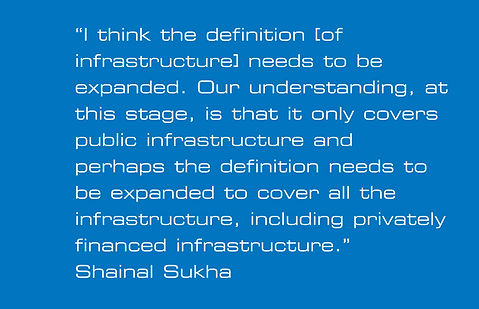
Last year, government unveiled 50 strategic infrastructure projects (Sips) and 12 special projects involving a total investment of R360bn, as the first tranche of a massive infrastructure expenditure programme to drive the post COVID-19 economic recovery effort.
These initial Sip projects are expected to create an estimated 275,700 jobs in six sectors: water and sanitation, energy, transport, digital infrastructure, agriculture and agro-processing, and human settlements.
The fact remains that South Africa is one of the most unequal countries in the world, and requires significant investment in infrastructure for all her people to enjoy the basic dignity of running water, electricity, tarred roads, health care and education.
However, a major question mark remains over how these projects will be funded.
In April 2020, we had calls from the private equity industry to increase prudential limits on asset allocation imposed by Regulation 28 of The Pension Funds Act, and to split the asset class from hedge funds.
The conversation became poisoned by the spectre of prescribed assets, which were used by the apartheid regime to terrible effect. However, done the right way, it could present a pathway to prosperity and out of South Africa’s COVID-induced economic depression.
The waiting is finally over. National Treasury released its draft amendments to Regulation 28 of the Pension Funds Act on 26 February 2021.
It is fundamentally about making it easier for retirement funds to increase investment in infrastructure, not prescription, as some fearmongers forewarned, and improve the measurement of infrastructure investment by the Financial Sector Conduct Authority (FSCA).
The amendments refer to infrastructure investment already permitted through various asset classes, and suggest unbundling the asset category related to “hedge funds, private equity funds and other assets”.
Delinking this asset category will make private equity a separate asset class with a higher investment limit.
So pretty much what Private Equity campaigned for, at least. But what do the pension funds and the so-called gatekeepers, their asset consultants, think of the proposals?
Soyisile Mokweni, Chairman of the Consolidated Retirement Fund, one of the fastest growing local government retirement funds in South Africa, which boasts approximately 52,000 members and roughly R32bn in assets under management, and one of the leading investing funds in alternatives, welcomes the move. It is admittedly one of the more progressive funds in the country when it comes to private equity, with 18,4% of its funds invested in alternatives.
“Given the fact that during the last six years, the JSE has been moving sideways, if you can't find Alpha in the places where you traditionally find the returns, you need to look elsewhere with your investment strategy, and that is the journey we started way back when Regulation 28 was amended
in 2011,” explains Mokweni.

The CRF is advised by Shainal Sukha, Managing Director of Sukha and Associates, an independent and black-owned asset consulting firm. These are the so-called ‘gatekeepers’.
Sukha welcomes the Amendments, in that they will now allow greater transparency, especially for funds that were previously invested through collective investment schemes, which are generally pooled funds and life policies, as that exemption has been removed.
“And so, under Regulation 28, if the current amendments go through, funds will receive greater transparency in terms of their underlying holdings in those life policies and collective investment schemes, which will allow funds to better track the overall allocation to infrastructure, whether it's through equity, debt, property or any other asset class,” explains Sukha. “I think it improves transparency, and it also allows government and other stakeholders, like the regulator, to be aware of the amount that retirement funds are actually already investing in infrastructure.”
Though Sukha feels the definitions require some tightening.


“I think that the definition [of infrastructure] needs to be expanded. Our understanding, at this stage, is that it only covers public infrastructure, and perhaps the definition needs to be expanded to cover all the infrastructure, including privately financed infrastructure. As you know, many retirement funds, including CRF, participated in a highly successful government program, the renewable energy program. So based on understanding, it seems that the REIPPP programme may not be recognised as infrastructure because it's privately financed. So, we would want to see that definition just expanded slightly.”

Anne-Marie D'Alton, CEO of Batseta, believes that one of the most important outcomes is that there is now an opportunity to mobilise retirement funds to approach this investment into infrastructure as a collective effort, to create that environment where funds can collaborate without compromising a decent, risk adjusted financial return, “where you can make sure that the investments really have an impact, that the jobs are created where they’re supposed to be created, and finally, that the retirement funds still have the right to decide whether they want to invest or not. And in that particular process, we will make sure, as Batseta, that retirement funds get the necessary training and education, and that they are exposed and able to improve their skills in this particular area.”
In a world where JSE listings are declining and investors are increasingly finding that the listed environment doesn’t afford the levels of protection one used to find comfort in, alternative assets are increasingly receiving consideration as suitable replacements for the long-term needs of pension funds. And the amended Regulation 28 looks likely, once the issues around definitions are addressed, to accelerate this trend.







